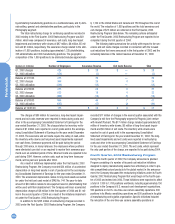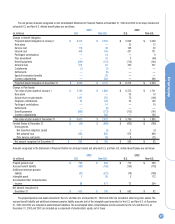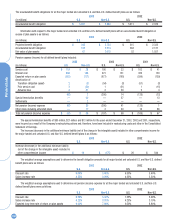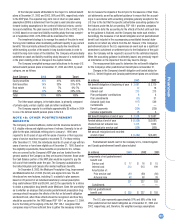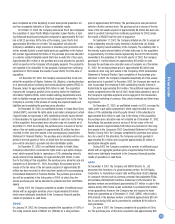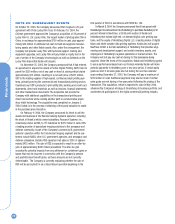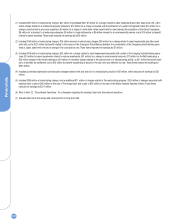Kodak 2003 Annual Report Download - page 70
Download and view the complete annual report
Please find page 70 of the 2003 Kodak annual report below. You can navigate through the pages in the report by either clicking on the pages listed below, or by using the keyword search tool below to find specific information within the annual report.
Financials
70
used to compute the other postretirement benefit amounts approximate
the U.S. assumptions.
The weighted-average assumptions used to determine the net bene-
fit obligations were as follows:
2003 2002
Discount rate 6.00% 6.50%
Salary increase rate 4.25% 4.25%
The weighted-average assumptions used to determine the net
postretirement benefit cost were as follows:
2003 2002
Discount rate 6.50% 7.25%
Salary increase rate 4.25% 4.25%
The weighted-average assumed healthcare cost trend rates used to
compute the other postretirement amounts were as follows:
2003 2002
Healthcare cost trend 11.00% 12.00%
Rate to which the cost trend rate
is assumed to decline (the ultimate
trend rate) 5.00% 5.00%
Year that the rate reaches the
ultimate trend rate 2010 2010
Assumed healthcare cost trend rates have a significant effect on the
amounts reported for the healthcare plans. A one percentage point change
in assumed healthcare cost trend rates would have the following effects:
1% increase 1% decrease
Effect on total service and interest cost $ 7 $ (7)
Effect on postretirement benefit
obligation 119 (108)
The Company expects to pay benefits of $258 million for its U.S.
other postretirement benefits plan in 2004.
NOTE 19: ACCUMULATED OTHER
COMPREHENSIVE (LOSS) INCOME
The components of accumulated other comprehensive (loss) income at
December 31, 2003, 2002 and 2001 were as follows:
(in millions) 2003 2002 2001
Accumulated unrealized holding
gains (losses) related to
available-for-sale securities $ 11 $ — $ (6)
Accumulated unrealized losses
related to hedging activity (15) (9) (5)
Accumulated translation
adjustments 107 (306) (524)
Accumulated minimum pension
liability adjustments (334) (456) (62)
Total $ (231) $(771) $(597)
NOTE 20: STOCK OPTION AND
COMPENSATION PLANS
The Company’s stock incentive plans consist of the 2000 Omnibus Long-
Term Compensation Plan (the 2000 Plan), the 1995 Omnibus Long-Term
Compensation Plan (the 1995 Plan) and the 1990 Omnibus Long-Term
Compensation Plan (the 1990 Plan). The Plans are administered by the
Executive Compensation and Development Committee of the Board of
Directors.
Under the 2000 Plan, 22 million shares of the Company’s common
stock may be granted to a variety of employees between January 1, 2000
and December 31, 2004. The 2000 Plan is substantially similar to, and is
intended to replace, the 1995 Plan, which expired on December 31, 1999.
Stock options are generally non-qualified and are at prices not less than
100% of the per share fair market value on the date of grant, and the
options generally expire ten years from the date of grant, but may expire
sooner if the optionee’s employment terminates. The 2000 Plan also pro-
vides for Stock Appreciation Rights (SARs) to be granted, either in tandem
with options or freestanding. SARs allow optionees to receive payment
equal to the increase in the Company’s stock market price from the grant
date to the exercise date. At December 31, 2003, 52,215 freestanding
SARs were outstanding at option prices ranging from $23.25 to $62.44.
Compensation expense recognized in 2003 on those freestanding SARs,
which had option prices less than the market value of the Company’s
underlying common stock, was not material.
Under the 1995 Plan, 22 million shares of the Company’s common
stock were eligible for grant to a variety of employees between February
1, 1995 and December 31, 1999. Stock options are generally non-quali-
fied and are at prices not less than 100% of the per share fair market
value on the date of grant, and the options generally expire ten years from
the date of grant, but may expire sooner if the optionee’s employment ter-
minates. The 1995 Plan also provides for SARs to be granted, either in
tandem with options or freestanding. At December 31, 2003, 319,409
freestanding SARs were outstanding at option prices ranging from $31.30
to $90.63.
Under the 1990 Plan, 22 million shares of the Company’s common
stock were eligible for grant to key employees between February 1, 1990
and January 31, 1995. The stock options, which were generally non-quali-
fied, could not have prices less than 50% of the per share fair market
value on the date of grant; however, no options below fair market value
were granted. The options generally expire ten years from the date of
grant, but may expire sooner if the optionee’s employment terminates.
The 1990 Plan also provided that options with dividend equivalents, tan-
dem SARs and freestanding SARs could be granted. At December 31,
2003, 41,034 freestanding SARs were outstanding at option prices rang-
ing from $30.25 to $44.50.
In January 2002, the Company’s shareholders voted in favor of a vol-
untary stock option exchange program for its employees. Under the pro-
gram, employees were given the opportunity, if they so chose, to cancel
outstanding stock options previously granted to them at exercise prices
ranging from $26.90 to $92.31, in exchange for new options to be granted
on or shortly after August 26, 2002, over six months and one day from
February 22, 2002, the date the old options were canceled. The number of
shares subject to the new options was determined by applying an
exchange ratio in the range of 1:1 to 1:3 (i.e., one new option share for
every three canceled option shares) based on the exercise price of the






